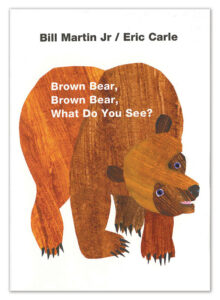Receptive language, Expressive language
Toddlers participate in a shared book reading focused on pictures of different animals.



[Invite several toddlers to join you to read a book. Show the cover of the book. Point to the words and picture on the cover as you introduce the book.]
This book is called Brown Bear, Brown Bear, What Do You See? This book is about seeing. We see things with our eyes.
 [Point to your eyes.]
[Point to your eyes.]
These are my eyes. Please point to our eyes.
[Encourage toddlers to point to their eyes.]
We will use our eyes to look at the pictures in our book! This is the brown bear. I am pointing to his eyes.
[Point to the bear’s eyes.]
The brown bear and other animals in our book use their eyes to see different animals.
What animals do you think we might see in our book today?
[Pause for toddlers to respond. Repeat and extend each response.]
Let’s read our book and find out what animals we will see!
[Open the book and hold it for each toddler to see. Ask the toddlers about the picture and respond positively to each reaction. Example: “Tiana said ‘bear.’ Yes, this is the brown bear from the cover of our book! Look, he has eyes and a nose and a mouth!”
Read the first page slowly and accentuate each word for toddlers to hear and understand.]
What animal do you think we will see on the next page?
[Pause to allow time for toddlers to respond and to create anticipation.]
Let’s turn the page and see!
[Turn the page and show enthusiasm for the animal pictured. Provide time for toddlers to look at the new picture.]
This is a red bird! The brown bear looked with his eyes and saw a red bird. The bird has red wings and a yellow beak. What else do we see?
[Pause for toddlers to respond.]
I wonder what animal the red bird will see on the next page. Are you ready for me to turn the page?
[Continue to read and talk about the pictures and words in the book using strategies, such as the following, to engage toddlers in the story:
The animals in our book used their eyes to see other animals. We used our eyes to see the different animals, too! Which animal was your favorite? Would you like to look at the picture of that animal again?
The illustrations of familiar animals are likely to sustain toddlers’ interests in the book. Pay attention to toddlers’ visual engagement of pictures. If toddlers seem focused on pictures and related discussion, provide information about animal characteristics, such as color, body parts, skin (fur, feathers), size, sounds, or actions (fly, hop, swim). Toddlers at this age are not expected to know or remember colors or body part names, but early awareness of concepts related to animal characteristics can contribute to vocabulary knowledge over time.
Toddlers are likely to connect with the rhythmic, repetitive text of the book. Some may join you in reciting some of the familiar words. Others may prefer to watch and listen. Positively recognize different forms of participation.
Extra support
Enrichment
Receptive language, Expressive language
Toddlers participate in a shared book reading and a follow-up activity focused on different animals.



 Invite several toddlers to read a book about animals with you. When you read the book, pause on each page to talk about what toddlers see in the picture. You may wish to invite toddlers to point to specific animals on the last page. Example: “Where is the purple cat on this page? Let’s point to the purple cat.”
Invite several toddlers to read a book about animals with you. When you read the book, pause on each page to talk about what toddlers see in the picture. You may wish to invite toddlers to point to specific animals on the last page. Example: “Where is the purple cat on this page? Let’s point to the purple cat.”
After the book sharing, introduce the toy animals and give each toddler one to hold. Use the words and cadence of the story text in a rhyme that includes each child’s name, one at a time. Example: “Tyler, Tyler, what do you see?” Encourage the toddler you name to hold up his/her toy animal. Some toddlers may say the name or make the sound of the animal. Finish the rhyme with a cadence and phrase that mirrors the book text. Example: “I see a bear looking at me!”
Recognize each toddler’s type of participation. Examples: “You said ‘meow,’ Madison. A cat says ‘meow.’ You see a cat looking at you!” “You are dancing your horse, Jeremiah. I think you like this song!”
Offer a second round of rhymes if time and child interest permit.
Toddlers enjoy hearing their name, especially in a song or rhyme. It is important to visually engage, with a big smile, the toddler who is featured in the rhyme. Gently try to get the attention of a toddler who does not look at you when you say his/her name in the rhyme. It is fine if a toddler does not hold up a toy animal when his/her name is offered in a rhyme. Participation may look different for each toddler.
Extra support
Enrichment
Receptive language, Expressive language
A toddler holds and manages a book to identify an animal puzzle piece that is the same as the animal featured on a book page.



Be Prepared: Use the animal pieces of the puzzle only for this activity.
 Invite a toddler to read a book with you and to find puzzle pieces that are the same as the animals shown in our book. Read the book with the toddler, pausing on each page to invite the toddler to point to the picture of the animal shown on the page. Point to (or invite the toddler to point to) and talk about physical characteristics of each animal, such as the cat’s tail, the bird’s wings, the sheep’s ears, and the horse’s long legs and tail.
Invite a toddler to read a book with you and to find puzzle pieces that are the same as the animals shown in our book. Read the book with the toddler, pausing on each page to invite the toddler to point to the picture of the animal shown on the page. Point to (or invite the toddler to point to) and talk about physical characteristics of each animal, such as the cat’s tail, the bird’s wings, the sheep’s ears, and the horse’s long legs and tail.
At the end of the book, ask the toddler to hold the book. Introduce 2–3 puzzle pieces, especially animals that seemed to be of special interest to the toddler. Point to and describe one of the puzzle pieces. Example: “This is the horse. Remember, there was a horse in our book. Let’s try to find the page of our book that shows the horse.” Provide verbal support for the toddler to hold the book and turn pages in search of the animal shown on the puzzle piece. Describe the toddler’s actions. Example: “You are turning the pages of the book carefully. You are looking at each page to find an animal that is the same as the animal shown on the puzzle piece.”
When the toddler finds the page featuring the animal shown on the puzzle piece, explain that the pictures of the animal are the same. Hold a different puzzle piece next to the book illustration and explain that the two animals are different. Point out that the toddler looked carefully to find in the book the animal that is the same as the animal shown on the puzzle piece.
Provide several more puzzle pieces for the toddler to consider, one at a time. It is not necessary for a toddler to search for all nine animals shown on puzzle pieces.
Conclude the activity by describing the toddler’s efforts. Example: “You turned pages of our book to find a picture of the animal shown on the puzzle. The picture of the animal in the book is the same as the picture of the animal on the puzzle piece.”
Notice how the toddler approaches each of the emerging skills promoted in the activity: holding the book, turning the pages of the book, and looking at animals shown on each page to find one that is the same as the animal shown on the puzzle piece. Managing the book, including page turning, supports motor skill development. Determining whether two pictures are the same or different promotes a cognitive skill. Focusing on each picture (in the book and in the puzzle piece) requires concentration, a self-regulation skill. Provide assistance when and where appropriate. It is important to avoid assuming full responsibility for one of the tasks in the activity, such as turning pages. When a caregiver holds the book and turns its pages, the toddler has no opportunity to practice how to manage a book.
It may be tempting to describe the activity as finding animal pictures that match. Using the concept of a match may be too advanced for some toddlers at this age. The activity description focuses on skills required for determining a match, particularly looking closely at pictures to determine whether they are the same or different. The concepts of same and different pertain to many other skills in life, and are not limited to finding a match.
The book and puzzle pieces emphasize color, but discourage the toddler from finding pictures that are the same color. Concentration skills are promoted when the toddler looks more carefully at features of the animal, such as those emphasized in the activity plan’s shared book reading approach. Also, animals come in different colors; not all birds are red, and a blue horse is quite novel!
Extra support
Enrichment
Materials Needed: Brown Bear, Brown Bear, What Do You See? by Bill Martin Jr & Eric Carle; several animal figures or stuffed animals similar to the animals in the book; Mudpuppy Eric Carle Brown Bear Color Pairs Puzzle (animal pieces only)
Place the book, animal figures, and animal puzzle pieces on a low table. Invite several toddlers to look at the book and then look at the items displayed on the table. Encourage toddlers to find a picture of the animal in the book that is the same as the animal shown on a puzzle piece (independent use of Option 3). Also, invite toddlers to find animal figures or stuffed animals that are like the animals shown on book pages.
Materials Needed: Brown Bear, Brown Bear, What Do You See? by Bill Martin Jr & Eric Carle; large paper secured to a low table; assortment of age-appropriate paintbrushes; paint smocks; assortment of paint colors
Be Prepared: Mix several shades of 2–3 paint colors. Example: Add white and black to the red to create several red shades to paint with, creating an ‘Eric Carle’ look.
Read this popular book with all interested children. Talk with children about what they see on each page. After the book reading, invite children to work together to paint a picture using the shaded colors similar to the pictures in the book. Talk with toddlers about the colors they are painting with, and the actions they are taking with the paintbrushes. Babies may enjoy exploring a small amount of finger paint on a high chair tray during the activity. Display the group artwork on the wall after the paint is dry.